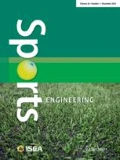Abstract
The main objective of this research was to develop a markerless optical motion capture system that can be used for daily use in swimming training. The butterfly stroke was targeted since it is considered bilaterally symmetric in motion. The system consisted of a segmentation process to obtain the participant’s silhouettes and a matching process to estimate the pose of the participant. A variable thresholding method was used to extract the silhouettes to solve non-uniform illumination in the recorded swimming video. Prior to the matching process, the human body was modeled as a series of nine segments to help the matching process. The model was then mapped so that it aligned with the silhouettes, which were investigated by similarity of intensity value. To minimize the degree of freedom in image matching, the available joint motion in the swimming human simulation model was used as a priori information for kinematics data of the swimming motion. As a result, the rotation angle’s correlation coefficients between the references and result of the matching process were around 0.95 for trunk, thigh, shank, upper arm, forearm, hand and 0.78 for head, hip and foot. The rotation angle and the velocity of the center of mass were put into the swimming human simulation model for a dynamics analysis. The simulation results show that the velocity obtained in the experiment corresponded to the fluid force exerted on the lower and upper limbs. Consequently, the proposed system of obtaining the joint motion of the butterfly stroke is suitable for daily training and coaching.










Similar content being viewed by others
References
Windolf M, Götzen N, Morlock M (2008) Systematic accuracy and precision analysis of video motion capturing systems—exemplified on the Vicon-460 system. J Biomech 41(12):2776–2780
Maletsky LP, Sun J, Morton NA (2007) Accuracy of an optical active-marker system to track the relative motion of rigid bodies. J Biomech 40(3):682–685
Whittle MW (2014) Gait analysis: an introduction. Butterworth-Heinemann, UK
Mihradi S, Ferryanto, Dirgantara T, Mahyuddin AI (2013) Tracking of Markers for 2D and 3D gait analysis using home video cameras. Int J E Health Med Commun (IJEHMC) 4(3):36–52
Monnet T, Samson M, Bernard A, David L, Lacouture P (2014) Measurement of three-dimensional hand kinematics during swimming with a motion capture system: a feasibility study. Sports Eng 17(3):171–181
Corazza S, Muendermann L, Chaudhari AM, Demattio T, Cobelli C, Andriacchi TP (2006) A markerless motion capture system to study musculoskeletal biomechanics: visual hull and simulated annealing approach. Ann Biomed Eng 34(6):1019–1029
Goffredo M, Carter JN, Nixon MS (2009) 2D markerless gait analysis. In: 4th European conference of the international federation for medical and biological engineering, Springer Berlin Heidelberg, pp 67–71
Mündermann L, Corazza S, Andriacchi TP (2010) U.S. Patent No. 7,804,998. U.S. Patent and Trademark Office, Washington, DC
Dubois RP, Thiel DV, James DA (2012) Using image processing for biomechanics measures in swimming. Procedia Eng 34:807–812
Ceseracciu E, Sawacha Z, Fantozzi S, Cortesi M, Gatta G, Corazza S, Cobelli C (2011) Markerless analysis of front crawl swimming. J Biomech 44(12):2236–2242
Nakashima M, Satou K, Miura Y (2007) Development of swimming human simulation model considering rigid body dynamics and unsteady fluid force for whole body. J Fluid Sci Technol 2(1):56–67
Maglischo EW (2003) Swimming fastest. Human Kinetics, Champaign
Moeslund TB, Hilton A, Krüger V (2006) A survey of advances in vision-based human motion capture and analysis. Comput Vis Image Underst 104(2):90–126
Zhang J, Hu J (2008) Image segmentation based on 2D Otsu method with histogram analysis. In: Computer science and software engineering, 2008 international conference on IEEE, vol 6, pp 105–108
Otsu N (1975) A threshold selection method from gray-level histograms. Automatica 11(285–296):23–27
Gonzalez RC, Woods R (2010) Digital image processing. Pearson Education, USA
Nakashima M (2014) Swimming human simulation software “Swumsuit”. http://www.swum.org/swumsuit/index.html. Accessed 19 June 2015
Information-Technology Promotion Agency (2014) Picture materials for education (swimming). http://www2.edu.ipa.go.jp/gz/h1swim/h1kn20/IPA-2kuro-ru.htm. Accessed 19 June 2015
Zitova B, Flusser J (2003) Image registration methods: a survey. Image Vis Comput 21(11):977–1000
Schmidt M (2016) Argmax and Max Calculus [PDF document]. https://www.cs.ubc.ca/~schmidtm/Documents/2016_540_Argmax.pdf. Accessed 26 July 2016
Poli R, Kennedy J, Blackwell T (2007) Particle swarm optimization. Swarm intelligence 1(1):33–57
Kwon YH (1998) DLT method. http://www.kwon3d.com/theory/dlt/dlt.html#dlt. Accessed 14 Mar 2016
Acknowledgments
The authors gratefully acknowledge the support from the Japan International Cooperation Agency (JICA) for the present study.
Author information
Authors and Affiliations
Corresponding author
Rights and permissions
About this article
Cite this article
Ferryanto, F., Nakashima, M. Development of a markerless optical motion capture system for daily use of training in swimming. Sports Eng 20, 63–72 (2017). https://doi.org/10.1007/s12283-016-0218-6
Published:
Issue Date:
DOI: https://doi.org/10.1007/s12283-016-0218-6




